Did you know a 2006 study found hydrocolloid pimple patches and skin tape can help with mild-to-moderate acne? Hydrocolloid patches were better at reducing breakouts, redness, and oil than skin tape1. Acne patches, also known as pimple patches or hydrocolloid patches, are now popular for treating spots. They stick to the skin and help it heal by soaking up drainage from wounds like pustules, papules, and cysts2.
Even though acne patches can help with some lesions, it’s important to know their limits on open wounds. They are not a cure-all for acne2. In this guide, we’ll look at how to use acne patches right, their good and bad sides, and when you should see a dermatologist for your skin issues.
Key Takeaways:
- Acne patches help by soaking up extra fluid and keeping the skin safe from bacteria, helping wounds like pustules and cysts heal faster.
- Hydrocolloid patches work best when worn overnight, as they need several hours to show their full effect.
- Not everyone can use acne patches, especially those with sensitive skin, because the adhesive might irritate them.
- Acne patches don’t work on closed lesions, blackheads, whiteheads, or cystic acne, and shouldn’t be seen as a fix for all acne problems.
- For acne, you can try over-the-counter stuff like salicylic acid and benzoyl peroxide, or prescription meds like retinoids and antibiotics.
- If your acne or wounds don’t get better, or if you have severe acne, see a dermatologist for the right care and treatment.
What Are Acne Patches and How Do They Work?
Acne patches, also known as pimple patches or hydrocolloid bandages, are a popular way to fight individual pimples. They help pimples heal faster. Almost everyone gets pimples at some point, showing how common acne is3. These skin care products create a barrier over pimples. They absorb extra fluids, target bacteria, and prevent dirt and bacteria from getting in3.
Hydrocolloid Patches for Wound Healing
Hydrocolloid acne patches are made from the same stuff used for wound dressing. They have a thick, sticky layer on a flexible film. Inside, they have materials like carboxymethylcellulose, gelatin, or pectin that attract water. This helps pull out fluid from the wound, while the outer layer keeps everything in place and stops water from evaporating.
These patches are great for open acne and are better than other types of patches4. A study showed that hydrocolloid patches helped manage acne better than surgical tape4. They also promote faster healing because of their antibacterial properties4.
Ingredients in Medicated Acne Patches
Some acne patches have extra ingredients to fight acne. Non-medicated patches are good for pimples with fluid or pus. Medicated patches have salicylic acid, benzoyl peroxide, or tea tree oil to fight inflammation and bacteria3.
Salicylic acid helps with blackheads and whiteheads but can dry out the skin3. Tea tree oil kills bacteria and reduces inflammation but might not work for severe acne and can cause allergies3. Patches with tea tree oil don’t absorb fluid, which can make pimples come back4.
Microneedling patches are a new way to treat acne. They have tiny needles to get ingredients like salicylic acid and tea tree oil into the skin35. These ingredients fight inflammation, dry out pimples, kill bacteria, hydrate the skin, and improve its look and feel5. Microneedling patches are better for severe acne, while hydrocolloid patches are good for surface-level pimples35.
Types of Acne Patches: Hydrocolloid, Medicated, and Microneedling
There are three main types of acne patches: nonmedicated, medicated, and microneedle. Each type has its own benefits and targets different types of acne.
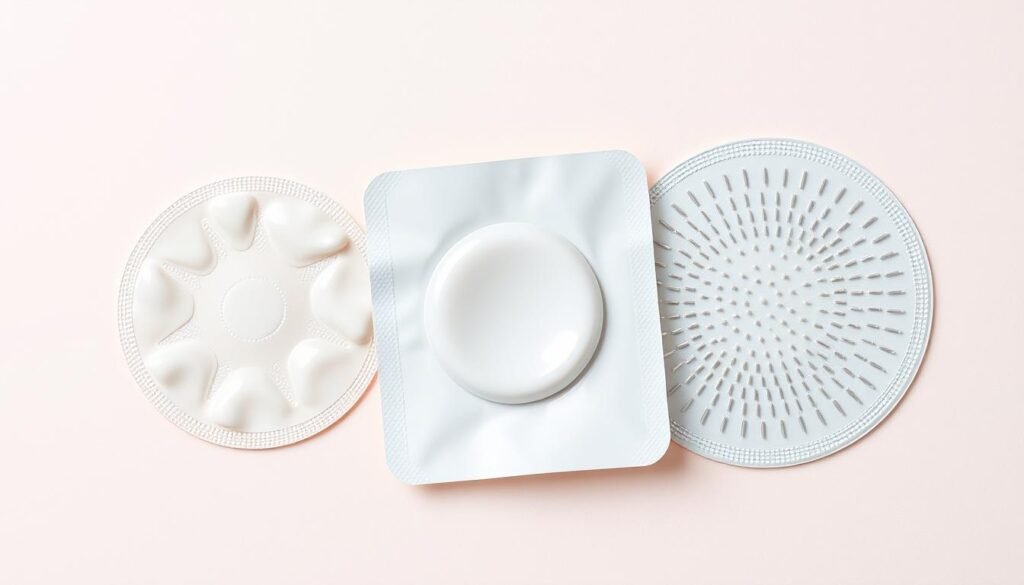
Nonmedicated patches, or hydrocolloid bandages, are great for pimples and whiteheads6. They absorb excess fluids and prevent picking. This makes them perfect for open or oozing lesions7. Patches like the Mighty Patch Original and Nexcare Acne Blemish Cover help the skin heal by trapping pus and impurities6.
Medicated patches contain ingredients like salicylic acid and tea tree oil. They help heal acne faster and reduce swelling67. These patches target cystic acne, papules, pustules, and nodules7. The Peter Thomas Roth Acne-Clear Invisible Dots and Rael Miracle Patch Microcrystal Spot Cover are popular choices. They use salicylic acid, hyaluronic acid, and tea tree oil to dissolve dead skin, hydrate, and reduce inflammation68.
Microneedle patches are a newer option. They have dissolving microneedles that push active ingredients deeper into the skin67. They’re good for deep nodular or cystic acne, as well as early-stage acne like blind pimples68. These patches contain ingredients like hyaluronic acid, salicylic acid, tea tree leaf oil, and niacinamide68. The Acropass Trouble Cure and ZitSticka KILLA Kit are examples of effective microneedle patches for severe cysts and nodules67.
| Acne Patch Type | Best For | Key Ingredients | Popular Products |
|---|---|---|---|
| Nonmedicated (Hydrocolloid) | Pimples, whiteheads, open or oozing lesions | Cellulose gum, hydrocolloid polymer technology | Mighty Patch Original, Nexcare Acne Blemish Cover, Peace Out Acne Healing Dots |
| Medicated | Cystic acne, papules, pustules, nodules | Salicylic acid, tea tree oil, hyaluronic acid, vitamin C, tranexamic acid | Peter Thomas Roth Acne-Clear Invisible Dots, Rael Miracle Patch Microcrystal Spot Cover |
| Microneedle | Deep nodular or cystic acne, blind pimples, post-inflammatory hyperpigmentation | Hyaluronic acid, salicylic acid, tea tree leaf oil, niacinamide, vitamin B3, polypeptide | Acropass Trouble Cure, ZitSticka KILLA Kit, Dr. Jart+ Focuspot Blemish Micro Tip Patch |
When using microneedle patches, press down for 15-30 seconds to penetrate the skin8. Leave them on for about six hours before removing8.
I love how acne patches have evolved to target different types of acne. Whether I’m dealing with a pesky whitehead or a painful cystic breakout, there’s a patch that can help me get clearer skin faster.
Understanding the different types of acne patches helps me choose the best one for my skin. This way, I can enjoy clearer, healthier-looking skin.
Benefits and Limitations of Using Acne Patches
Acne patches can help manage individual pimples, especially open and pus-filled ones. They use hydrocolloid technology to absorb excess fluid and create a moist environment for healing910. This technology also acts as a protective barrier, keeping the area safe from irritants and preventing picking, which can make things worse9.
Advantages of Acne Patches for Spot Treatment
Acne patches have several benefits for spot treatments:
- They reduce inflammation and redness4
- They absorb excess oil and sebum4
- They protect the skin while it heals9
- They can alleviate pain by creating a barrier between the skin and the environment9
Research shows that hydrocolloid pimple patches are more effective than other types of patches4. Some patches also include ingredients like tea tree oil or salicylic acid to help with healing10.
Acne Patches Are Not a Cure-All for Breakouts
While acne patches are good for managing individual pimples, they have their limits. They work best on open, draining lesions but may not help with closed comedones, blackheads, or deeper cystic acne9. Patches also don’t solve the underlying causes of acne or stop new breakouts9.
It’s key to remember that acne patches can’t clear clogged pores or treat the root causes of acne9. If you have persistent or severe acne, patches alone might not be enough. You might need a more detailed plan that includes cleansers, topical treatments, and sometimes oral antibiotics104.
While acne patches can be a useful tool in your spot treatment arsenal, they are not a one-size-fits-all solution for preventing and managing breakouts.
Can I Use Acne Patch on Open Wound?
Acne patches are made to help heal pimples, but using them on open wounds needs careful thought. If you have sensitive skin, be extra cautious. Hydrocolloid patches soak up discharge from wounds without drying them out11. But, the adhesive might irritate your skin, especially if you’re allergic or have sensitive skin.
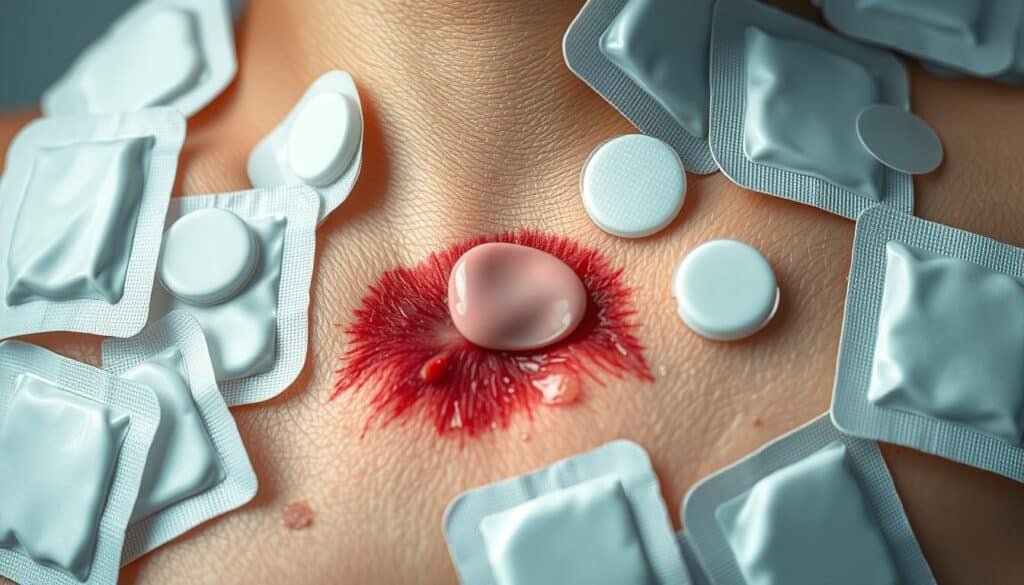
Safety Considerations for Using Acne Patches on Open Wounds
Be careful with acne patches on open wounds if you have sensitive skin. Some patches have ingredients like salicylic acid and hyaluronic acid. These can make your skin sensitive12. Patches with benzoyl peroxide or salicylic acid might leave red marks on sensitive skin12.
Start with a simple hydrocolloid patch if you’re unsure. These patches are less likely to cause side effects12. If you’re allergic to adhesives or ingredients, avoid using acne patches altogether.
When to Avoid Using Acne Patches
Hydrocolloid patches are best for certain pimples, but not all wounds. Here are times to avoid using them:
- They won’t stick well to very wet wounds.
- They’re not effective on very dry wounds.
- Don’t use them on infected wounds11.
- They won’t help with cystic acne or blackheads11.
For wound healing, hydrocolloid dressings are better for certain types of wounds11. Always think about your wound’s type and severity before using an acne patch. This ensures healing and avoids irritation or complications.
Proper Application and Usage of Acne Patches
Using acne patches right is key to a good skincare routine. You need to prepare your skin and apply the patches correctly. This ensures they stick well and work on your blemishes effectively.
Cleansing and Preparing the Skin Before Application
Start by washing your hands to avoid bacteria. Then, clean the area around the pimple with a gentle cleanser13. This removes dirt and oil, helping the patch stick and work better.
Apply the patch after cleansing, treating it as a spot treatment13. But, be careful with exfoliants and retinoids in your routine. They might irritate your skin with the patch13.
After cleaning and drying, remove the patch from its packaging. Find the sticky side and apply it over the pimple. Press it gently to seal it to your skin13.
Leave the patch on for several hours or overnight, as the product suggests13. Hydrocolloid patches can stay on for 3 to 7 days, making healing easier14.
When it’s time to remove the patch, you’ll see a gel-like substance. This is the patch’s work, absorbing the pimple’s contents13. Clean the area and moisturize it to help with healing.
By following these steps, you can get the most out of acne patches. They help clear your skin. Remember, using them consistently and patiently is important, as results can vary1315.
Alternative Treatments for Acne and Open Wounds
Acne patches can be helpful, but they’re not for everyone. There are many treatments available to fight breakouts and heal wounds. These options kill bacteria, reduce swelling, and help skin cells grow back.
Over-the-Counter Acne Medications
Many over-the-counter products fight acne and help heal popped pimples. They have antibacterial properties16. Common and effective ingredients include:
- Salicylic acid
- Benzoyl peroxide
- Topical retinoids (like adapalene)
- Azelaic acid
These ingredients clear pores, reduce swelling, kill bacteria, and help skin cells grow. Natural options like aloe vera, tea tree oil, and honey are also good for acne and wounds16. Always test new products on a small area first to avoid bad reactions, especially with aloe vera and other natural ingredients17.
Prescription Treatments for Severe Acne
For serious acne, a dermatologist might prescribe stronger meds. These include:
- Oral antibiotics
- Isotretinoin
- Corticosteroid injections
- Hormonal therapy
Oral antibiotics and isotretinoin target bacteria and reduce swelling. Corticosteroid injections quickly shrink and ease cystic acne. Hormonal therapy helps women with acne caused by hormonal imbalances. These treatments are great for severe acne that can’t be popped at home16.
Seeing a dermatologist is key to finding the right treatment. They can guide you through the options, considering benefits and risks. They’ll create a plan that might include topical treatments, oral antibiotics, and more for the best results.
When to Consult a Dermatologist for Acne and Wound Care
Dealing with acne can be tough. Sometimes, what you buy at the store isn’t enough. If your acne doesn’t get better, it’s time to see a dermatologist. They can give you professional skin care advice that fits your skin health needs4.
A dermatologist can find out why your acne is happening. They might look at hormonal issues or skin sensitivity. Then, they can suggest treatments that work best for you5.
They might give you stronger creams, antibiotics, or other treatments. This can help clear your skin and stop future breakouts5.
If you have a wound that’s not healing, you should see a doctor. They can help with wound care and give antibiotics if needed. They’ll watch your wound to avoid scarring or other problems10.
Your skin is huge and important. It needs expert help for serious issues like acne or wounds. Don’t wait to see a dermatologist for advice and treatments that can make your skin better.
Working with a dermatologist can lead to a better skin care plan. This plan will address your specific problems and keep your skin healthy for a long time.
Conclusion
Acne patches can be a good and safe way to treat acne if used right. Knowing the types, ingredients, and what they can’t do helps me use them wisely. It’s key to clean and prepare my skin before applying patches and watch for any allergies.
Studies show that chitosan and gelatin in patches can fight bacteria and help wounds heal18. But, remember, patches alone can’t solve all acne problems. For serious cases, seeing a dermatologist is best.
When using patches on open wounds, I need to be careful and follow wound care advice. If I have a bad reaction or the wound doesn’t heal right, I should get medical help. Using patches right, along with other treatments and a good skincare routine, can help me get clearer skin.
The market for pimple patches is getting bigger, with many options at various prices19.
Success with acne patches comes from being patient, consistent, and listening to my skin. Keeping up with new research and advice helps me make the best choices for my skin. With the right approach and a positive mindset, I’m on my way to healthier, clearer skin.
FAQ
Can I use acne patches on open wounds?
What types of acne patches are available?
How do I properly apply an acne patch?
Can acne patches prevent future breakouts?
When should I consult a dermatologist for acne and wound care?
Source Links
- What Does a Pimple Patch Actually Do, and Is It Worth the Hype? – https://www.health.com/hydrocolloid-patches-7556580
- Do Pimple Patches Actually Work? – https://health.clevelandclinic.org/how-do-pimple-patches-work
- Understanding Pimple Patches: A Comprehensive Guide | BHSkin – https://bhskin.com/blog/understanding-pimple-patches-a-comprehensive-guide/
- What Are Hydrocolloid Patches for Pimples? – https://www.webmd.com/skin-problems-and-treatments/acne/what-are-hydrocolloid-patches-for-pimples
- Pimple Patches and What They Offer – American Chemical Society – https://www.acs.org/education/chemmatters/articles/pimple-patches-and-what-they-offer.html
- 10 Best Acne Patches to Try Now – https://www.healthline.com/health/beauty-skin-care/acne-patches
- What are the different types of acne? Which acne patch should I choose? – Medtecs Group – https://www.medtecs.com/types-of-acne/
- Pimple Emergency? Here’s How to Use a Pimple Patch – https://www.herocosmetics.us/blogs/news/how-to-use-a-pimple-patch
- How Do Acne Patches Work? (And Why It’s Not the Best for Acne) – https://www.exposedskincare.com/blogs/blog/how-do-acne-patches-work
- Should You Use Wound Care on Acne Breakouts? – https://www.byrdie.com/acne-wound-treatment
- How Do Hydrocolloid Bandages Work for Healing Acne & Minor Wounds | BAND-AID® Brand – https://www.band-aid.com/first-aid-info/first-aid-basics/how-do-hydrocolloid-bandages-work
- Do Pimple Patches Work? – https://www.verywellhealth.com/do-pimple-patches-work-7504785
- Using Pimple Patches? Don’t Make The Same Mistake That I Did – https://www.refinery29.com/en-us/pimple-patches-mistakes-issues
- What Is in Hydrocolloid Bandages, and How Are They Used? – https://www.healthline.com/health/what-is-in-hydrocolloid-bandages
- Hydrocolloid dressings, bandages, and patches – https://www.medicalnewstoday.com/articles/hydrocolloid
- 6 Steps to Heal a Popped Pimple Fast – https://www.verywellhealth.com/how-to-heal-a-popped-pimple-15493
- People Are Getting Rid of Pimples by Putting Adhesive Bandages on Them—Here’s What Derms Have to Say – https://www.health.com/condition/acne/bandaids-for-acne
- Gelatin/Chitosan Bilayer Patches Loaded with Cortex Phellodendron amurense/Centella asiatica Extracts for Anti-Acne Application – https://www.ncbi.nlm.nih.gov/pmc/articles/PMC7918957/
- Should I Put a Pimple Patch on a Popped Pimple? – https://fazitbeauty.com/blogs/learn-more/should-i-put-a-pimple-patch-on-a-popped-pimple


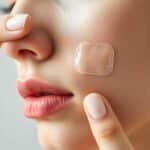
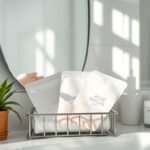
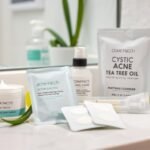
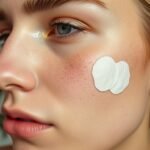
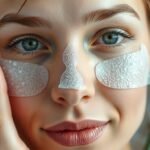

Are acne patches really safe on open wounds, though? I mean, arent they just glorified stickers with a fancy name?
Theyre more than fancy stickers. Science-backed, safe, and effective at healing. Research before you knock it!
Personally, I wonder if using acne patches on wounds might actually slow healing. Also, whats the deal with medicated ingredients? Any thoughts?
Interesting read, but arent medicated acne patches too harsh for open wounds? Id think twice before slapping one on a cut.
Interesting read, but arent these patches just a fancy, overpriced band-aid? Are there any actual medical benefits or is it all just marketing hype?
Interesting read, but why not explore natural remedies for acne? Not everything needs a patch or medication, right guys? Just a thought.
Anyone else think acne patches could double as mini-bandages for small cuts? Seems like a hack waiting to be discovered!
Hmm, but are there any long-term effects of using acne patches on wounds? Just thinking about skin sensitivity issues here. 🤔
Sounds crazy, but what if we used acne patches for quick wound healing? Any thoughts? Just throwing it out there!
Interesting idea! But arent acne patches designed specifically for pimples? Would they work on wounds?
Anyone else think acne patches are just glorified band-aids with a hefty price tag? Why not just use regular hydrocolloid bandages?
Anyone else think that acne patches could be a secret weapon for quick wound healing? Lets lobby for more research!